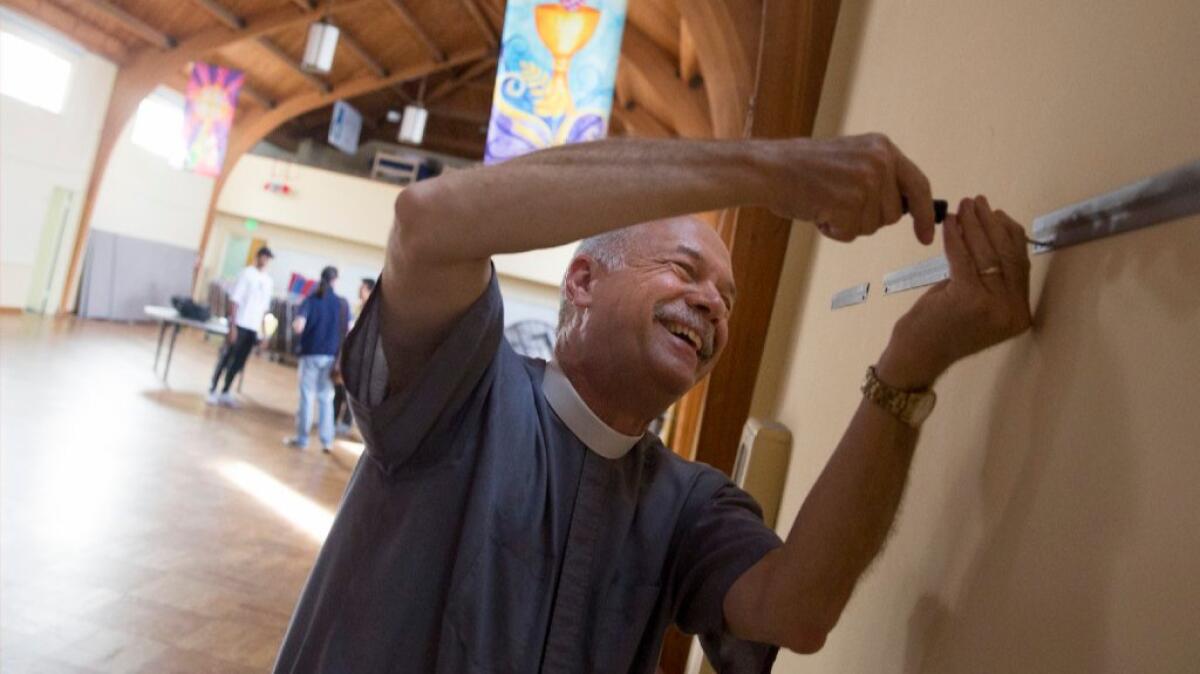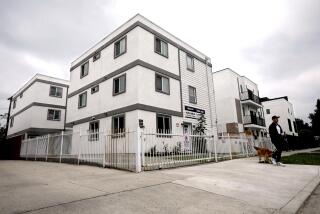A groundbreaking homeless shelter for college students in Santa Monica hits a snag

The Rev. Eric Shafer interrupted me before I could even get my first sentence out.
“I understand you are opening a shelter for homeless college stu—”
“It’s really exciting,” exclaimed Shafer, who is pastor of Santa Monica’s Mt. Olive Lutheran Church. “The coolest thing in the world!”
Shafer and his church have joined forces with Bruin Shelter, a new charity started by UCLA graduate students to help alleviate homelessness among college students. This is believed to be one of the first shelters for college students run by college students.
“Wow,” said Barbara Duffield of the National Assn. for the Education of Homeless Children and Youth. “That is pretty cool. We are seeing different approaches to the issue of college students who are homeless, and this is definitely a novel one.”
Last week, I joined the ebullient, 66-year-old Shafer for a tour. He said he didn’t really think twice about joining forces with Bruin Shelter, that his church supported it, as well as the local neighborhood association. “Why wouldn’t we do this? It’s what we should do based on God’s love for all people. We are doing it as an example to other communities of faith, and we are doing it to tweak UCLA into doing what they should be doing.”
We walked into the church’s vaulted multipurpose room, then up a flight of stairs in the back to a loft, which has been furnished with five bunk beds and a few other pieces of furniture. Thirty people applied for a bed through Bruin Shelter’s website, said Lauren Dy, 25, a UCLA social welfare graduate student and co-president of the group. Nine have been selected: five from UCLA and four from Santa Monica College.
If all goes well, on Oct. 2, the cozy space will become their home for 11 hours a day, between 8 p.m. and 7 a.m. There will be hot meals, and at least two volunteers on site at all times.
Though no one knows exactly how many college students are homeless, it is most certainly in the tens of thousands here in California. A recent Cal State University survey found that 1 in 10 of the system’s 460,000 students are homeless. Nine beds, of course, will hardly make a dent.
“I think of that old cliche about the man on the beach with a thousand starfish,” Shafer said, “throwing them back in one by one, and someone says, ‘Why are you doing that? It doesn’t mean anything.’ And he says, ‘Means a lot for this one.’”
::
Just after I met Shafer, I began to hear rumblings that the city of Santa Monica was not on board with the shelter. For a city that is lampooned by Harry Shearer as the “home of the homeless,” this came as a surprise.
City officials told me Wednesday that the shelter does not comply with a laundry list of California building and safety codes, as necessary as they are inflexible.
“We recognize that this is a hard balance to strike,” said Santa Monica City Manager Rick Cole, “but we have to be vigilant at enforcing the laws that protect the health and safety of everyone.”
His main concern, he said, is the staircase that leads to the loft. It is not wide enough, per state codes for residential buildings. Nor is it clear, he said, that the loft is strong enough to withstand the load of all those students, beds and belongings. “We could probably figure that out, but it requires more analysis,” he said.
The shelter also lacks required showers, though it has bathrooms (and students will have access to their respective school gyms).
Shafer said he wasn’t worried about the loft’s structural integrity; it was built to hold the church’s 60-person choir. As for exits, he said, besides the stairwell, the loft has two fire ladders for emergencies.
Cole sounded genuinely torn, loath to criticize the good works of a pastor whom he described as a “valued and treasured community leader.”
“It would be one thing to say, we don’t want homeless people in our church,” Cole told me. “That is not our attitude. If they could even minimally comply, or we had a reasonable plan for getting to that, we would enthusiastically support them.”
There is also a larger, philosophical problem, he said.
“To the average person, it’s ‘Why don’t you provide a cot? A cot is better than sleeping under a bridge.’ But we have been providing cots for 30 years, and the problem is worse and more intractable than it was.”
The solution to homelessness, Cole said, is finding permanent supportive housing.
Of course, you would think that such a thing exists on every university campus in the country. Generally speaking, we call these things “dorms.”
::
I can’t fault Santa Monica College for failing to provide housing; after all, like most community colleges, it was conceived as a commuter school. But what about UCLA? Has that great institution fallen down on its obligation to provide housing?
Not at all, said UCLA Dean of Students Maria Blandizzi.
UCLA does not have a homeless shelter, per se, but it has many resources available to students in dire financial straits. It offers two weeks of emergency housing in residence halls for those in crisis, and lots of other kinds of help — with food, with counseling, with figuring out financial aid when they are dependent on parents in the eyes of the government but in reality are not receiving family support.
“Are there students out there saying, ‘The university is not helping me,’ or ‘It’s not affordable’? I am sure there are. Could we do better? Yes, we could. But do we do a lot? Yes, we do.”
Some students, she said, are simply “loan averse.” “I can’t make a student take out a loan, just like I can’t make them wear shoes.”
“We recognize that UCLA has taken steps, but we can all do better,” said Louis Tse, a former UCLA mechanical engineering graduate student who dreamed up Bruin Shelter, which has about 80 volunteers. He was shocked by how many people he saw living on the streets when he moved to Los Angeles from Arizona in 2011.
“It’s everywhere and unavoidable,” he said, including on campus, where students curl up on couches in common areas, or couch surf. More than a year ago, Tse gave up his apartment and began living out of his car to save money for Bruin Shelter, which has raised about $35,000. Tse, 27, who was recently hired by the Jet Propulsion Laboratory to work on the 2020 Mars rover project, has put in a fair chunk of that amount himself.
When he and shelter co-founder Luke Shaw, 25, a fellow engineering graduate student, finally connected with Mt. Olive a few months ago, it seemed like a perfect fit.
For the city, not so much.
But given the commitment of these students, the passion of this pastor, and the city’s goodwill, I have faith they’ll be able to work something out.
Twitter: @AbcarianLAT
To read the article in Spanish, click here
ALSO
L.A. expands homeless outreach program
Turning shipping containers into homes for the homeless
Dry heat and strong winds roll into the Southland; gusts down trees
More to Read
Sign up for Essential California
The most important California stories and recommendations in your inbox every morning.
You may occasionally receive promotional content from the Los Angeles Times.











